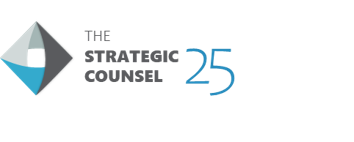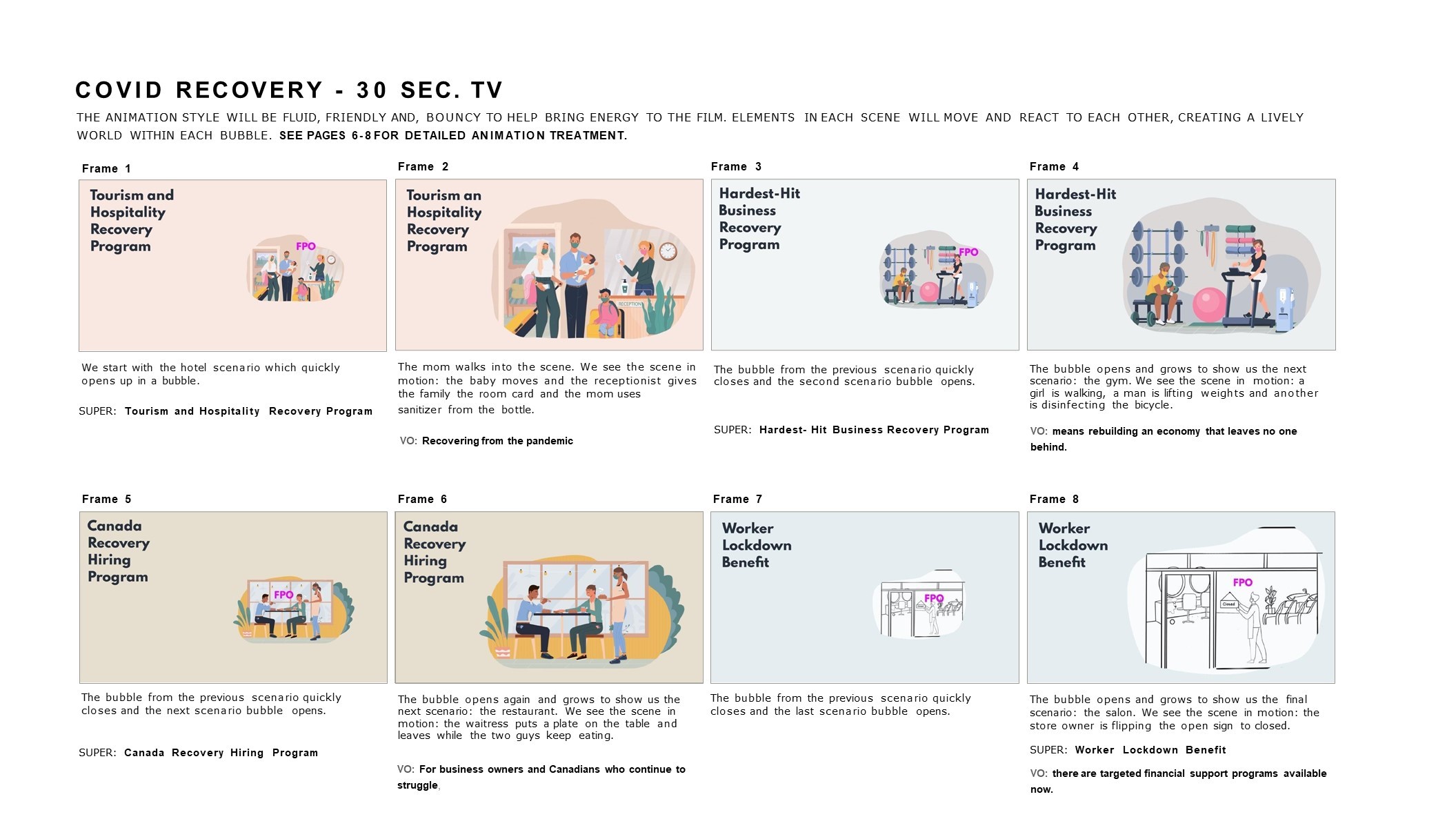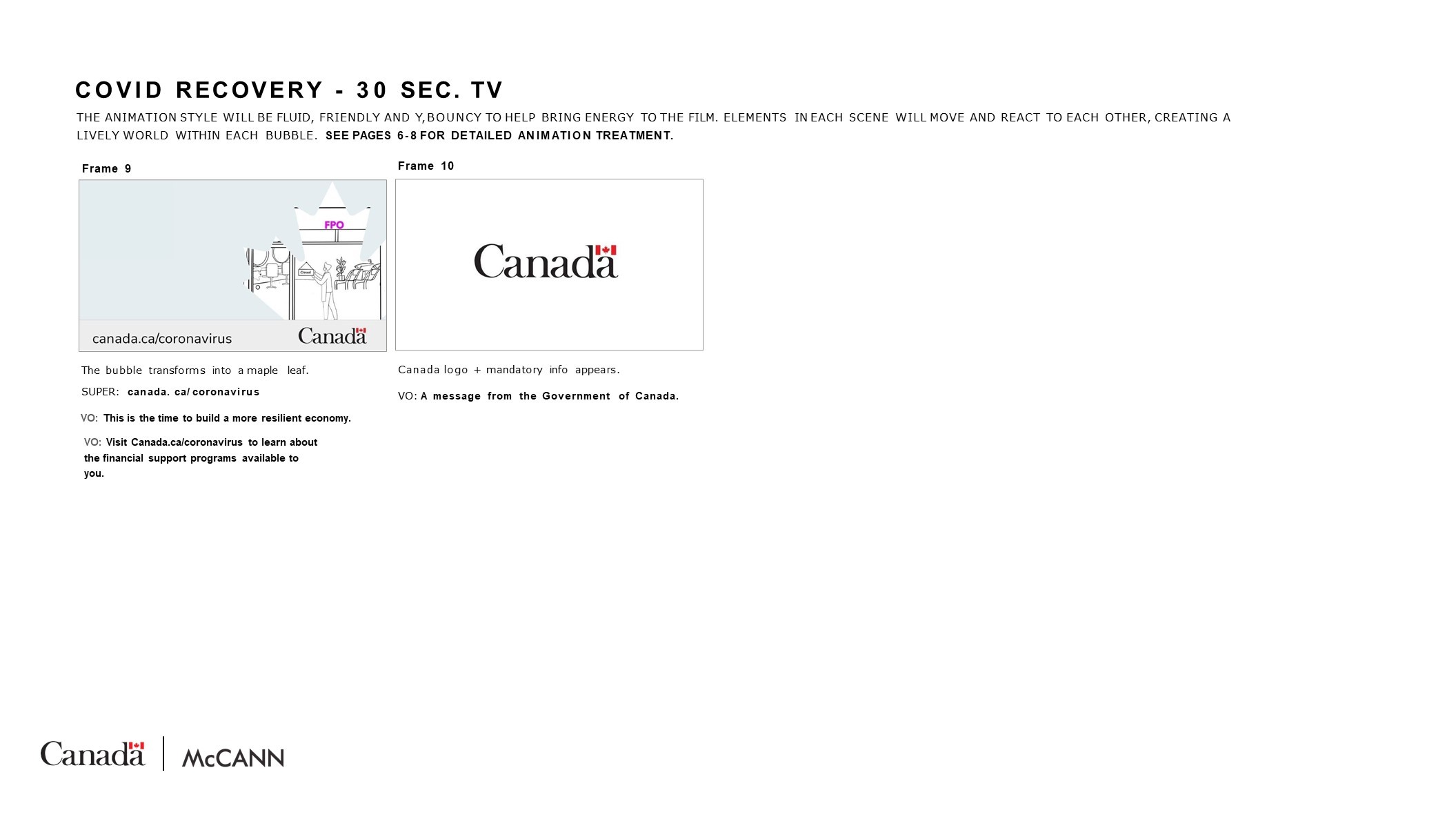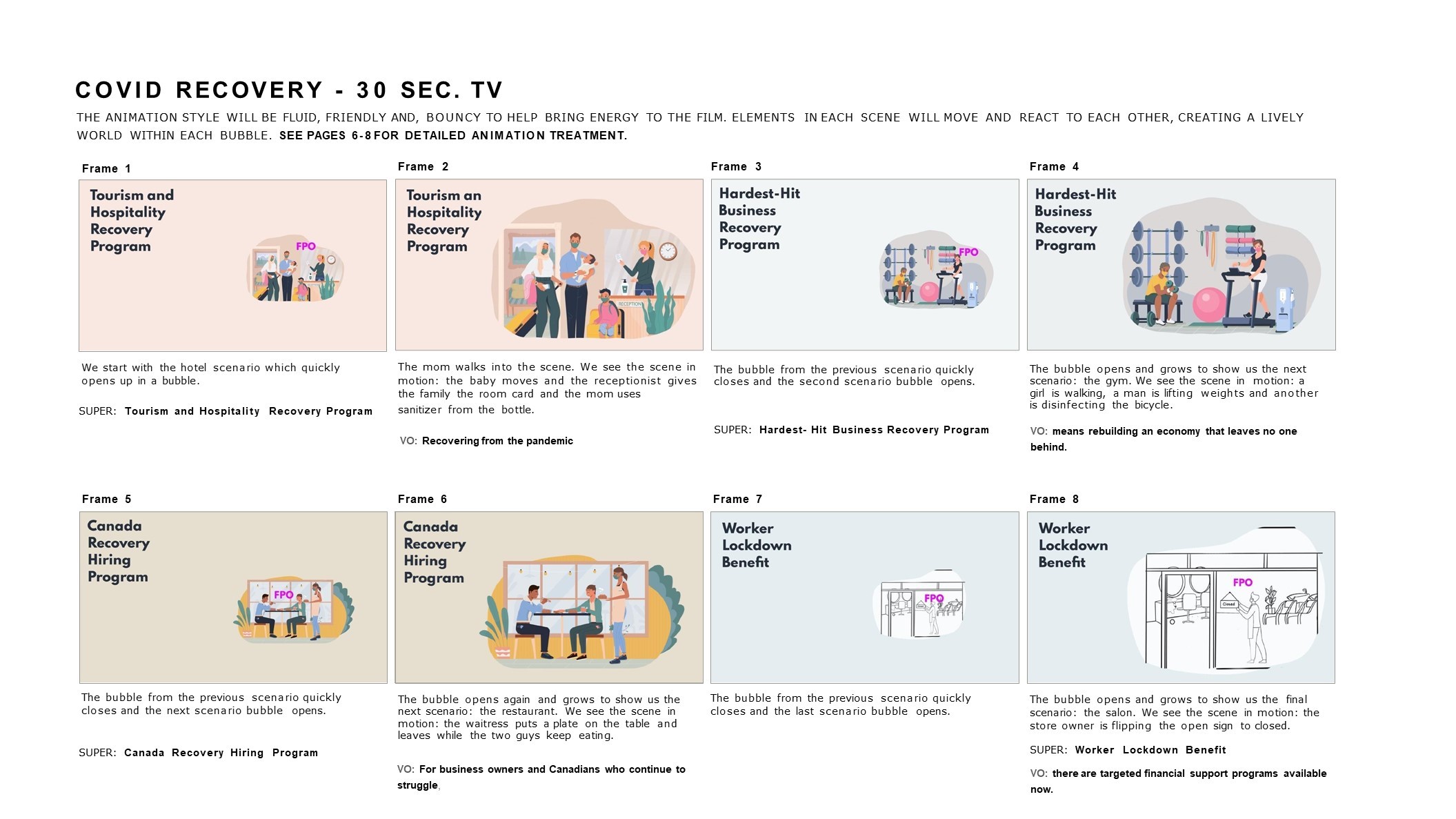



Target audience
| LOCATION | GROUP | LANGUAGE | DATE | TIME (EST) | GROUP COMPOSITION | NUMBER OF PARTICIPANTS |
|---|---|---|---|---|---|---|
| Northern Ontario | 1 | English | Dec. 1 | 6:00-8:00 pm | General Population | 8 |
| Southern Alberta | 2 | English | Dec. 2 | 8:00-10:00 pm | General Population | 7 |
| Eastern Ontario | 3 | English | Dec. 6 | 6:00-8:00 pm | Travellers | 7 |
| Quebec City | 4 | French | Dec. 7 | 6:00-8:00 pm | Parents of Children Under 12 | 6 |
| Lower Mainland B.C. | 5 | English | Dec. 7 | 9:00-11:00 pm | Prospective Homeowners | 7 |
| City of Toronto | 6 | English | Dec. 8 | 6:00-8:00 pm | Opinion Leaders | 8 |
| New Brunswick | 7 | French | Dec. 9 | 5:00-7:00 pm | Francophones | 7 |
| Mid-size and Major Centres B.C. | 8 | English | Dec. 9 | 9:00-11:00 pm | General Population | 6 |
| Major Centres Manitoba | 9 | English | Dec. 13 | 7:00-9:00 pm | Parents of Children Under 12 | 6 |
| Major Centres Alberta | 10 | English | Dec. 14 | 8:00-10:00 pm | Prospective Homeowners | 6 |
| Northwest Territories | 11 | English | Dec. 14 | 8:00-10:00 pm | General Population | 6 |
| Greater Montreal Area (GMA) | 12 | French | Dec. 15 | 6:00-8:00 pm | Travellers | 7 |
| Total number of participants | 81 | |||||

The above storyboard begins with the first and second frame labeled “Tourism and Hospitality Recovery Program.” An illustration of a family checking into a hotel in a bubble is shown. Beneath each frame is a description of what viewers would see in the final 30-second video advertisement. For the first two frames the description reads, “We start with the hotel scenario which quickly opens up in a bubble. The mom walks into the scene. We see the scene in motion: the baby moves and the receptionist gives the family the room card and the mom uses sanitizer from the bottle.” Frame 3 and 4 are labeled “Hardest-Hit Business Recovery Program” and take place in a gym. The description reads, “The bubble from the previous scenario quickly closes and the second scenario bubble opens. The bubble opens and grows to show us the next scenario: the gym. We see the scene in motion: a girl is walking, a man is lifting weights and another is disinfecting the bicycle.” On the second line, frame 5 and 6 are labeled “Canada Recovery Hiring Program” and include a bubble showing two people sitting at a table. The description reads, “The bubble from the previous scenario quickly closes and the next scenario bubble opens. The bubble opens again and grows to show us the next scenario: the restaurant. We see the scene in motion: the waitress puts a plate on the table and leaves while the two guys keep eating.” Frame 7 and 8 are labeled “Worker Lockdown Benefit” and are accompanied with the following description: “The bubble from the previous scenario quickly closes and the last scenario bubble opens. The bubble opens and grows to show us the final scenario: the salon. We see the scene in motion: the store owner is flipping the open sign to closed.”

The final two frames close the storyboard with a blank screen with a maple leaf along with the official Government of Canada logo. The description reads, “The bubble transforms into a maple leaf. Canada logo and mandatory info appears.”
This video was only shown to a French group, and as such, no English version was produced. The above video begins with a frame titled « programme de relance pour le tourisme et l’accueil, » with an image in a bubble of a family entering a hotel. In the next frame, the voiceover reads, « se remettre de la pandémie signifie… » while the receptionist gives the family their room key, the father is holding a small infant, and the mother uses hand sanitizer. The third frame, titled « programme de relance pour les entreprises les plus durement touchées, » depicts an image in a bubble of a gym with a girl walking on a treadmill and a man lifting weights while seated. The voiceover continues, « rebâtir une économie qui ne laisse personne pour compte. » The next scene, titled « programme d’embauche pour la relance économique du Canada, » depicts two men seated at a table in a restaurant, with a waitress putting a plate on their table. The voiceover says, « pour les propriétaires d’entreprises et les Canadiens qui éprouvent toujours des difficultés… ». The next frame titled, « prestation canadienne pour les travailleurs en cas de confinement, » opens with an image in a bubble of a hair salon with an employee flipping the sign from « ouvert » to « fermé ». The voiceover continues, « …des programmes de soutien financier cibles sont disponibles aujourd’hui. » The image of the hair salon transforms into the outline of a maple leaf, and the voiceover says, « Consultez Canada.ca/le-coronavirus pour connaitre les programmes de soutien financier qui vous sont offerts. » The final frame depicts the Government of Canada logo with the voiceover ending the clip with, « Un message du gouvernement du Canada. »

In the above image, the word ‘Canada’ is written in black font over a white background. Over the final ‘a’ there is a coloured, red and white, Canadian flag.
Above is a short, two-second, audio clip featuring the opening notes of the Canadian national anthem.
| GROUP | DATE | TIME (EDT) | TIME (LOCAL) | LOCATION | COMPOSITION | MODERATOR |
|---|---|---|---|---|---|---|
| 1 | Wed., December 1st | 6:00-8:00 | 6:00-8:00 (EST) | Northern Ontario | General Population | DN |
| 2 | Thurs., December 2nd | 8:00-10:00 | 6:00-8:00 (MST) | Southern Alberta | General Population | TBW |
| 3 | Mon., December 6th | 6:00-8:00 | 6:00-8:00 (EST) | Eastern Ontario | Travellers | DN |
| 5 | Tues., December 7th | 9:00-11:00 | 6:00-8:00 (PST) | Lower Mainland B.C. | Prospective Homeowners | TBW |
| 6 | Wed., December 8th | 6:00-8:00 | 6:00-8:00 (EST) | City of Toronto | Opinion Leaders | DN |
| 8 | Thurs., December 9th | 9:00-11:00 | 6:00-8:00 (PST) | Mid-size and Major Centres B.C. | General Population | TBW |
| 9 | Mon., December 13th | 7:00-9:00 | 6:00-8:00 (CST) | Major Centres Manitoba | Parents of Children Under 12 | DN |
| 10 | Tues., December 14th | 8:00-10:00 | 6:00-8:00 (PST) | Major Centres Alberta | Prospective Homeowners | TBW |
| 11 | Tues., December 14th | 8:00-10:00 | 6:00-8:00 (MST) | Northwest Territories | General Population | DN |
| LOCATION | CITIES | |
|---|---|---|
| Northern Ontario | Cities could include (but are not limited to): Sudbury, Thunder Bay, Sault Ste. Marie, North Bay, Timmins, Kenora, West Nipissing, Elliot Lake, Temiskaming Shores, Kapuskasing, Dryden
NO MORE THAN 2 PER CITY. ENSURE A GOOD MIX OF CITIES ACROSS THE REGION. INCLUDE THOSE RESIDING IN LARGER AND SMALLER COMMUNITIES. |
CONTINUE - GROUP 1 |
| Southern Alberta | Cities could include (but are not limited to): Lethbridge, Medicine Hat, Brooks, High River, Taber, Coaldale, Pincher Creek, Carston, Turner Valley, Vulcan
NO MORE THAN 2 PER CITY. ENSURE A GOOD MIX OF CITIES ACROSS THE REGION. INCLUDE THOSE RESIDING IN LARGER AND SMALLER COMMUNITIES. |
CONTINUE - GROUP 2 |
| Eastern Ontario | Cities could include (but are not limited to): Ottawa, Kingston, Kanata, Belleville, Cornwall, Brockville, Pembroke, Petawawa, Rockland, Carleton Place, Hawkesbury, Arnprior
NO MORE THAN 2 PER CITY. ENSURE A GOOD MIX OF CITIES ACROSS THE REGION. INCLUDE THOSE RESIDING IN LARGER AND SMALLER COMMUNITIES. |
CONTINUE - GROUP 3 |
| Lower Mainland B.C. | Cities include: Vancouver, Abbotsford, Burnaby, Coquitlam, Richmond, Surrey, Delta, Langley, White Rock, Chilliwack, Mission Hope, Maple Ridge, New Westminster, North Vancouver, Port Coquitlam, Port Moody ENSURE A GOOD MIX OF CITIES ACROSS THE REGION. NO MORE THAN TWO PER CITY. INCLUDE THOSE RESIDING IN LARGER AND SMALLER COMMUNITIES. |
CONTINUE - GROUP 5 |
| City of Toronto | Toronto
PARTICIPANTS SHOULD RESIDE IN THE ABOVE-NOTED CENTER PROPER. |
CONTINUE - GROUP 6 |
| Mid-size and Major Centres B.C. | Cities could include (but are not limited to): Vancouver, Victoria, Kelowna, Abbotsford, Surrey, Richmond, White Rock, Nanaimo, Kamloops, Chilliwack, Prince George, Vernon, Courtenay, Campbell River, Penticton, Mission MAX 2 PARTICIPANTS FROM MAJOR CITIES (VANCOUVER/VICTORIA). ENSURE A GOOD MIX OF CITIES ACROSS THE REGION. |
CONTINUE - GROUP 8 |
| Major Centres Manitoba | Cities include: Winnipeg and Brandon
PARTICIPANTS SHOULD RESIDE IN THE ABOVE-NOTED CENTERS PROPER. NO MORE THAN 4 PER CITY. |
CONTINUE - GROUP 9 |
| Major Centres Alberta | Cities include: Calgary, Edmonton, Red Deer
PARTICIPANTS SHOULD RESIDE IN THE ABOVE-NOTED CENTERS PROPER. NO MORE THAN 3 PER CITY. |
CONTINUE - GROUP 10 |
| Northwest Territories | Cities include (but not limited to): Yellowknife, Hay River, Inuvik, Fort Smith ENSURE A GOOD MIX OF CITIES ACROSS THE REGION. INCLUDE THOSE RESIDING IN LARGER AND SMALLER COMMUNITIES. |
CONTINUE - GROUP 11 |
| Less than two years | THANK AND END |
|---|---|
| Two years or more | CONTINUE |
| Don’t know/Prefer not to answer | THANK AND END |
| Child | Age |
|---|---|
| 1 | |
| 2 | |
| 3 | |
| 4 | |
| 5 |
| Under 18 years of age | IF POSSIBLE, ASK FOR SOMEONE OVER 18 AND REINTRODUCE. OTHERWISE THANK AND END. |
|---|---|
| 18-24 | CONTINUE |
| 25-34 | |
| 35-44 | |
| 45-54 | |
| 55+ | |
| VOLUNTEERED Prefer not to answer |
THANK AND END |
| Male | CONTINUE |
|---|---|
| Female | CONTINUE |
| GROUPE | DATE | HEURE (DE L’EST) | HEURE (LOCALE) | LIEU | COMPOSITION DU GROUPE | MODÉRATEUR |
|---|---|---|---|---|---|---|
| 4 | 7 décembre | 18 h-20 h | 18 h-20 h (HNE) | Ville de Québec | Parents d’enfants de moins de 12 ans | M. Proulx |
| 7 | 9 décembre | 17 h-19 h | 18 h-20 h (AST) | Nouveau-Brunswick | Population générale | M. Proulx |
| 12 | 15 décembre | 18 h-20 h | 18 h-20 h (HNE) | Grande région de Montréal (GRM) | Voyageurs internationaux | M. Proulx |
| LIEU | VILLES | |
|---|---|---|
| Ville de Québec | Ville de Québec.
LES PARTICIPANTS DOIVENT RÉSIDER DANS LESDITS CENTRES. |
CONTINUER - GROUPE 4 |
| Nouveau-Brunswick | Les villes du N-B. peuvent notamment comprendre : Campbellton-Miramichi, Moncton-Richibucto, Edmundston-Woodstock, Fredericton-Oromocto, Saint John-St. Stephen
ASSURER UNE BONNE REPRÉSENTATION DES VILLES DE LA PROVINCE. PAS PLUS DE DEUX PARTICIPANTS PAR VILLE. RECRUTER DES RÉSIDENTS DE GRANDES ET DE PETITES COLLECTIVITÉS. |
CONTINUER - GROUPE 7 |
| Grande région de Montréal (GRM) | Les villes de la GRM peuvent notamment comprendre : Montréal, Laval, Longueuil, Terrebonne, Brossard, Saint-Jérôme, Blainville, Mirabel, Dollard-des-Ormeaux
PAS PLUS DE DEUX PARTICIPANTS DE LA VILLE DE MONTRÉAL. ASSURER UNE BONNE REPRÉSENTATION DES VILLES DANS CHAQUE LIEU. |
CONTINUER - GROUPE 12 |
| Autre lieu | - | REMERCIER ET CONCLURE |
| RÉPONSE SPONTANÉE Préfère ne pas répondre | - | REMERCIER ET CONCLURE |
| Moins de deux ans | REMERCIER ET CONCLURE |
|---|---|
| Deux ans ou plus | CONTINUER |
| Ne sais pas/Préfère ne pas répondre | REMERCIER ET CONCLURE |
| Enfant | Âge |
|---|---|
| 1 | |
| 2 | |
| 3 | |
| 4 | |
| 5 |
| Moins de 18 ans | SI POSSIBLE, DEMANDER À PARLER À UNE PERSONNE DE 18 ANS OU PLUS ET REFAIRE L’INTRODUCTION. SINON, REMERCIER ET CONCLURE.. |
|---|---|
| 18 à 24 | CONTINUER ASSURER UNE BONNE REPRÉSENTATION DES ÂGES DANS CHAQUE GROUPE. |
| 25 à 34 | |
| 35 à 44 | |
| 45 à 54 | |
| 55 ans ou plus | |
| RÉPONSE SPONTANÉE Je préfère ne pas répondre | REMERCIER ET CONCLURE |

In the above image, the word ‘Canada’ is written in black font over a white background. Over the final ‘a’ there is a coloured, red and white, Canadian flag.
Above is a short, two-second, audio clip featuring the opening notes of the Canadian national anthem.

The above storyboard begins with the first and second frame labeled “Tourism and Hospitality Recovery Program.” An illustration of a family checking into a hotel in a bubble is shown. Beneath each frame is a description of what viewers would see in the final 30-second video advertisement. For the first two frames the description reads, “We start with the hotel scenario which quickly opens up in a bubble. The mom walks into the scene. We see the scene in motion: the baby moves and the receptionist gives the family the room card and the mom uses sanitizer from the bottle.” Frame 3 and 4 are labeled “Hardest-Hit Business Recovery Program” and take place in a gym. The description reads, “The bubble from the previous scenario quickly closes and the second scenario bubble opens. The bubble opens and grows to show us the next scenario: the gym. We see the scene in motion: a girl is walking, a man is lifting weights and another is disinfecting the bicycle.” On the second line, frame 5 and 6 are labeled “Canada Recovery Hiring Program” and include a bubble showing two people sitting at a table. The description reads, “The bubble from the previous scenario quickly closes and the next scenario bubble opens. The bubble opens again and grows to show us the next scenario: the restaurant. We see the scene in motion: the waitress puts a plate on the table and leaves while the two guys keep eating.” Frame 7 and 8 are labeled “Worker Lockdown Benefit” and are accompanied with the following description: “The bubble from the previous scenario quickly closes and the last scenario bubble opens. The bubble opens and grows to show us the final scenario: the salon. We see the scene in motion: the store owner is flipping the open sign to closed.”

The final two frames close the storyboard with a blank screen with a maple leaf along with the official Government of Canada logo. The description reads, “The bubble transforms into a maple leaf. Canada logo and mandatory info appears.”
This video was only shown to a French group, and as such, no English version was produced. The above video begins with a frame titled « programme de relance pour le tourisme et l’accueil, » with an image in a bubble of a family entering a hotel. The voiceover reads, « se remettre de la pandémie signifie rebâtir une économie qui ne laisse personne pour compte, » while the receptionist gives the family their room key, the father is holding a small infant, and the mother uses hand sanitizer. The third frame, titled « programme de relance pour les entreprises les plus durement touchées, » depicts an image in a bubble of a hair salon with an employee adjusting the sign reading “closed”. The voiceover continues, « pour les propriétaires d’entreprises et les Canadiens qui éprouvent toujours des difficultés… ». The next scene, titled « programme d’embauche pour la relance économique du Canada, » depicts two men seated at a table in a restaurant, with a waitress putting a plate on their table. The voiceover continues, « …des programmes de soutien financier cibles sont disponibles aujourd’hui. » The next frame titled, « prestation canadienne pour les travailleurs en cas de confinement, » opens with an image in a bubble of a gym with a girl walking on a treadmill and a man lifting weights while seated. The voiceover continues, « c’est le moment de bâtir une économie plus résiliente. Consultez Canada.ca/le-coronavirus pour connaitre les programmes de soutien financier qui vous sont offerts. » The final frame depicts the Government of Canada logo with the voiceover ending the clip with, « Un message du gouvernement du Canada. »